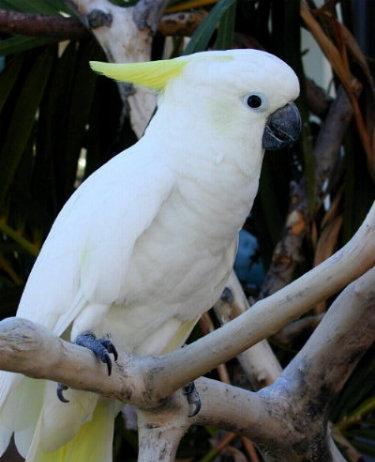Cockatoo - Eleonora
Greater Sulfur Crested Cockatoo, Medium Sulphur Crested Cockatoo Scientific Name: Cacatua galerita eleonora
Fri, 4th April, 2025 - 4:18 pm GMT
Sponsor Ads:

Alternative Name
Greater Sulfur Crested Cockatoo, Medium Sulphur Crested Cockatoo Scientific Name: Cacatua galerita eleonoraBasic Info
Like many other cockatoo species, the Eleonora Cockatoo is a larger parrot, measuring 16 inches (40.6 centimeters) to 18 inches (45.7 centimeters) in length. They have striking white plumage throughout and a beautiful yellow crest, hence their other name, Medium Sulphur Crested Cockatoo. They also have striking yellow feathers under their wings and bellies. They can be distinguished from other subspecies by their smaller beaks. Males, females, and immature individuals can be distinguished by eye color. Both the males and juveniles have darker eyes than females. After two to three years of age, the female's iris will turn a brownish-red color. Before they have reached this age, if you wish to determine the sex of your parrot, you will need to either use DNA sexing or surgical sexing methods.
Health
Like other parrots the Eleonora Cockatoo should be fed a varied diet. In the wild they feed on nuts, berries, flower buds, flowers, seeds, and insects. In captivity their diets should also be quite varied and they should be given an assortment of food to stay healthy. The Eleonora Cockatoo may be prone to behavior problems such as feather plucking and screaming, if they are not given enough attention. This fact needs to be considered before bringing one of these magnificent birds into your home. The Eleonora Cockatoo has a reputation as an escape artist and one may need to purchase a special lock for their cage to prevent unwanted escapes. Breeding The Eleonora is bred regularly in captivity. The female will lay between 2 and 3 eggs, which incubate for approximately 29 days.Habitat
Most commonly seen in open woodlands, forests, and semi-arid forested areas, as well as partially cleared forestsBehavior
The Eleonora Cockatoo is a striking bird that is quite popular in the pet trade, though they are one of the more expensive parrots, making them less common than their popularity might suggest. The Eleonora Cockatoo is one of four subspecies of Sulphur Crested Cockatoo. All of these are quite popular in the pet trade, but are often not recommended for beginners. These are highly intelligent birds, which require much attention from their owners. They may also suffer from boredom, because of their intelligence, and should be given plenty of toys and opportunity to interact with their owners. They are hard chewers and should be given plenty of chew toys otherwise they may be destructive. Like most cockatoos, they are not known to be good talkers, but there are always exceptions. If you are looking for a bird with a strong talking ability, this may not be the bird for you. Like most cockatoos the Eleonora Cockatoo is a social bird that is seen traveling in large flocks in the wild. For this reason, in captivity they require environments where they are given plenty of attention. If they are not allowed a lot of interaction with their owners, behavioral problems, such as screaming and feather plucking may result. In general, the Eleonora Cockatoo is a loud bird and may be even louder during daytime hours when they are left alone. For this reason they may not be suitable for apartment living. The Eleonora Cockatoo is very affectionate and will usually form a close bond with their owners. They usually love to be cuddled and snuggled as well. Because of their high intelligence, they can often be taught many tricks and are not uncommon in pet shows where parrots perform for audiences. They are generally not nervous and typically do not become startled easily. They should be allowed out of their cages regularly, though they should be closely supervised, as they are curious and known to roam. The Eleonora Cockatoo is also known as the Greater Sulfur Crested Cockatoo and as the Medium Sulphur Crested Cockatoo. It has been reported that hand-raised Eleonoras are less noisy than those that are not. Additionally they are reported to be more independent than some other species of cockatoo.Origin
Aru Islands and IndonesiaHistory
The Eleonora Cockatoo is native to Indonesia and the Aru Islands. It is also seen in the Kai Islands, but it is theorized that they are not native to this region, and were instead introduced. Though they are often seen in areas inhabited by humans, the Eleonora Cockatoo is most commonly seen in open woodlands, forests, and semi-arid forested areas, as well as partially cleared forests. They are not uncommon in the wild, though populations have decreased because of habitat destruction, hunting, and trapping for use in the pet trade.Common Foods
N/ASponsor Ads:
Skinner's Constant (Flanagan's Finagling Factor): That quantity which, when multiplied by, divided by, added to, or subtracted from the answer you get, gives the answer you should have gotten.
Cockatoo - Eleonora
Coded by: BGID® | ALL RIGHTS RESERVED Copyright © 2000-2025
Disclaimer | Privacy | Report Errors / Contact | Credits








 President of the United States of America - Real Estate mogul, Pageant owner and now one of the most controversial men in political history.
President of the United States of America - Real Estate mogul, Pageant owner and now one of the most controversial men in political history.  Politician, US Vice President and President of the USA - Joseph Robinette Biden Jr.
Politician, US Vice President and President of the USA - Joseph Robinette Biden Jr.  versus
versus  Russia: 'The Evil Empire'? Are they all that bad or is it just the USA trying to portray Russia as bad because they are a world power with land bigger and a society very different from the USA ideal?
Russia: 'The Evil Empire'? Are they all that bad or is it just the USA trying to portray Russia as bad because they are a world power with land bigger and a society very different from the USA ideal?  Global warming has been in and out as the "latest" hot topic for many years. It is, according to modern scientists, the result of man-made industrial pollutants, clearing forested areas, agriculture, etc. But now they are thinking it started way before the Industrial Revolution...
Global warming has been in and out as the "latest" hot topic for many years. It is, according to modern scientists, the result of man-made industrial pollutants, clearing forested areas, agriculture, etc. But now they are thinking it started way before the Industrial Revolution... 
 Corona virus
Corona virus 
 Users with wide screen monitors can benefit from more content on every page.
Users with wide screen monitors can benefit from more content on every page.